The Clarkdale Review: Intel's Core i5 661, i3 540 & i3 530
by Anand Lal Shimpi on January 4, 2010 12:00 AM EST- Posted in
- CPUs
Ridiculously Fun to Overclock
We’ll start off with the obligatory maximum stock VID overclock of a 661 ES Clarkdale using Intel’s retail cooler:
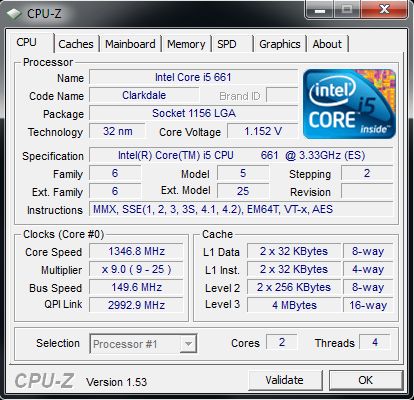
Maximum overclock @ stock voltages (3874MHz)
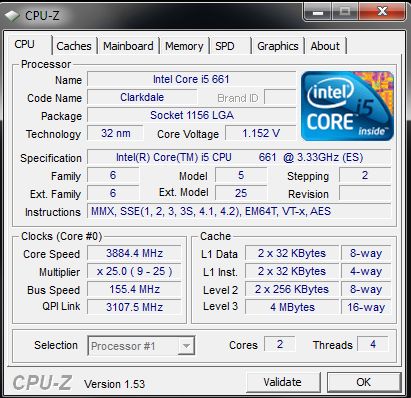
Maximum overclock @ stock voltages without Turbo
With increased core VID, speeds up to 4.3GHz are possible on the stock cooler:
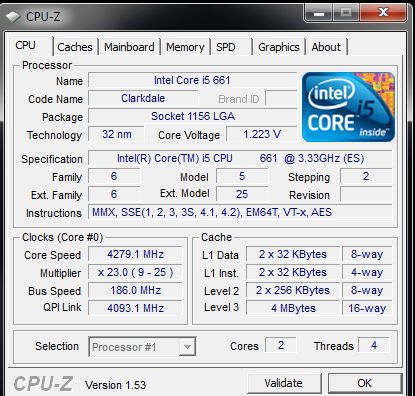
A 0.1V boost puts you in the 4.3GHz ballpark.
Watercooling
Clock for clock performance of Clarkdale against other platforms may not be impressive, but frequency scaling with good cooling is:

4853 MHz stable comes in with a processor load voltage of around 1.438V. Memory performance is related directly to the QPI link ratio. For best performance, keep the QPI link speed as close as possible to CPU core speed to minimize buffer hold times for lower memory access latency.
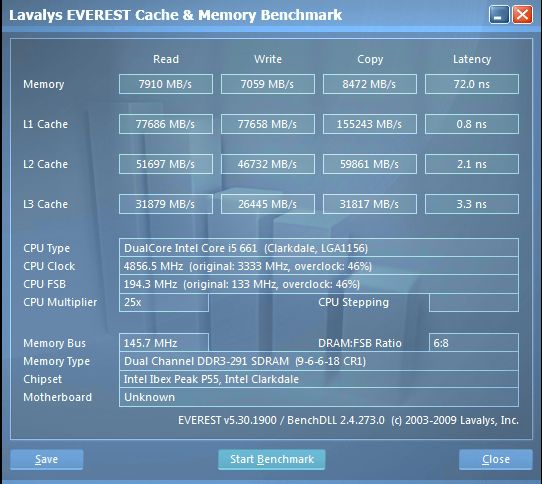
12X QPI Multiplier
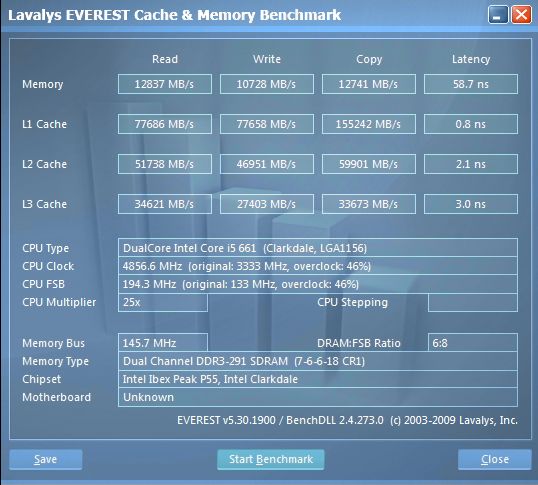
24X QPI Multi
The bandwidth figures are not stellar on either side of the scale (bear in mind the Everest bench DLL needs an update for Clarkdale). However, the higher QPI multiplier ratio is essentially free for the taking; requiring no additional IMC (VTT) voltage increase until BCLK is increased past 210 or so.
Like Lynnfield and Bloomfield, odd CPU multiplier ratios are more stable than even, although the disparity is less pronounced on Clarkdale. We found that even multipliers needed higher VCore at the same overall processor frequency or needed to be run at a lower overall overclock for stability. We’re not sure on the exact cause of this issue but it’s likely to be related to frequency synthesis within the CPU and downstream logic sampling.
Another caveat with Clarkdale overclocking is that the platform seems to be limited to memory speeds below 1600MHz as soon as you increase BCLK significantly (speeds over 1600Mhz are possible at stock BCLK). We’d hedge bets this is due to the memory controller relying on a preset DRAM clock skew table like Intel’s Front Side Bus architectures of old. The current DRAM frequency ceiling means that you’ll be shooting for CAS 5/6 capable memory between 1300-1600MHz for best performance with 4GB of RAM. 8GB configurations require a loose set of sub-timings, and also a 2N Command Rate to achieve 1600 MHz stable on our sample processor.
Sub-Zero
Bloomfield was hit and miss when it came to frequency scaling at low temperatures. Clarkdale seems to be a different animal altogether:
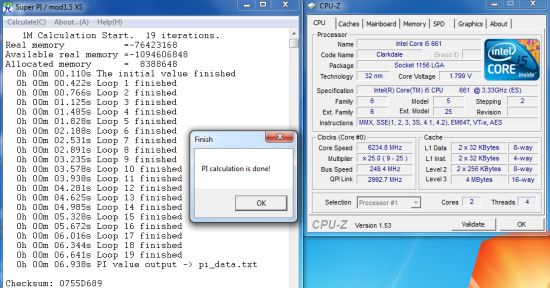
This is what ‘Clarkie’ is good at..
This screenshot was taken with our cascade cooling the CPU. Evaporator head temperatures were in the region of -115 Celsius. Most Lynnfield/Bloomfield CPUs were out of their comfort zone at these temperatures, but Clarkdale seems to be at home. You still get the occasional cold boot bug, but most of the ES CPUs will run benchmarks right down to the boiling point of LN2 (motherboard permitting). We’ve seen screenshots of 3D benchmarking above 6.5GHz and Super Pi runs edging close to 7GHz. Sounds great, but unfortunately, Super Pi 1M is the only benchmark where Clarkdale is really competitive. Once you’re past 230 BCLK, you have to leave QPI frequency on the floor which hurts memory performance in a big way. Couple that with the 1600MHz or so cap on DRAM frequency and you’ll understand why Super Pi 32m doesn’t fare so well on this platform. 3D performance in Futuremark’s 3DMark05 is just about competitive with the current ‘top’ Bloomfield results if you can run Clarkdale at 6.5GHz throughout the bench. The upshot is that we think there will be more good Clarkdale chips capable of 6.5GHz than there are Bloomfield CPUs that can run 3D benchmarks at 5.4GHz. The funny thing is that P55 motherboards using an NF200 to provide triple CrossFire/SLI might actually be the way to go for benchmarks like 3D Mark 05 if you’re into competitive benchmarking!
While Clarkdale may not be the fastest performer from Intel, it’s probably the most fun to overclock.










93 Comments
View All Comments
Marcin - Monday, January 4, 2010 - link
2D loadAnand Lal Shimpi - Monday, January 4, 2010 - link
The Radeon HD 5870 is quite power efficient if it's not running a 3D app. Our load tests were done using our x264 encoding benchmark to stress the CPU. That's why I used the 5870 as a companion in those benchmarks - makes overall system power consumption lower so we can better see differences between CPUs. Good job AMD :)Take care,
Anand
yacoub - Monday, January 4, 2010 - link
Intel gives us this crap instead of 32nm P55.DrMrLordX - Monday, January 4, 2010 - link
Can we see results on an i3 530 instead? Some people with ES chips are reporting that i3s are not good for much of anything over 4 ghz. Also, the vcore on your 4.8 ghz is pretty high, even with water cooling. I would not want to run an i3 at that vcore on a daily basis.The phase results are really interesting, but I have to wonder how well this chip scales given the memory speed limitations you run into at higher BCLK.
Spoelie - Monday, January 4, 2010 - link
First CPU-Z screenshot on the overclocking page shows CPU @ 1.3GHz, I don't think this is the correct shot?Rajinder Gill - Monday, January 4, 2010 - link
Speedstep and Turbo enbaled. The full load speed is 26X149 BCLK, so around 3874MHz..Spoelie - Monday, January 4, 2010 - link
True, comment on gaming benchmarks:" the Core i3s are good gaming chips - especially when you consider how far you can overclock them. "
But how would you know, not having any in-house?
Anand Lal Shimpi - Monday, January 4, 2010 - link
I've heard some very good initial results but I will be able to confirm when I get back from CES :)Take care,
Anand
marc1000 - Monday, January 4, 2010 - link
Suddenly it all makes sense. Intel would never enable 1080p decoding on Atom D510 not because of technical issues, but simply because it would kill the market for i3 even before it was released. The HTPC market does not need the i3 brute-power, but this is the only platform that will have HDMI and 1080p. If Atom D510 could do 1080p and had HDMI output then the choice for a HTPC would be a no-brainer. And excuse me, but I already have a gaming rig, so all I want right now is a HTPC to play PC content on my TV. And I won't buy a core i3 to do that, but I would buy a decent Atom board if it had the required HDMI and 1080p... so, for me, no HTPC for now...Kjella - Monday, January 4, 2010 - link
That is why the old Atom + ION exists, excellent setup with 1080p acceleration and HDMI out. If you don't want it, wait until AMD or VIA/nVidia manages to work something out.